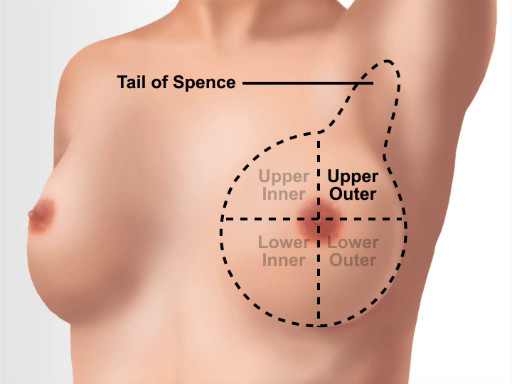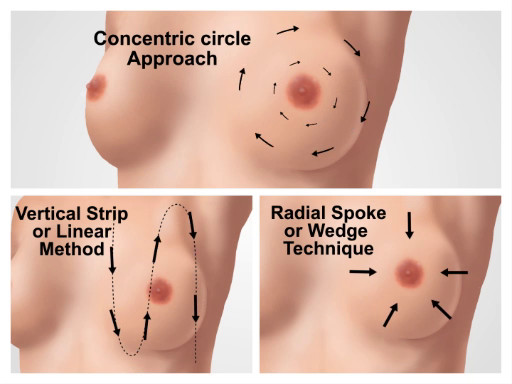全面的乳房检查
Overview
资料来源:
亚历山德拉 · 邓肯,GTA,实践临床,纽黑文康涅狄格
蒂凡尼库克,GTA,实践临床,纽黑文康涅狄格
Jaideep S.Talwalkar,MD、 内科、 儿科,耶鲁大学医学院,纽黑文,康涅狄格
乳房检查年度妇科考试关键部分,重要所有患者,不论其性别或性别的表达。8 的妇女将被诊断为乳腺癌;男性乳腺癌,虽然较少,但一生的发生率在 1000年 1。
乳房检查能感觉到创病人,所以它是重要的是尽一切可能使患者感到舒适和授权,而不是脆弱。考官应意识到他们沟通,口头和非口头的和给他们的病人控制尽可能 (例如,总是允许它们删除他们自己的礼服)。考官可以选择利用病人的伴侣 (和他们) 舒适。一些机构所需的伴侣。
虽然它始终是重要的是避免过于临床语言,某些口语词可以越过界限,照顾到在这次考试过于亲密。它有利于避免单词"接触"和"感觉",在这次考试,因为这种语言能感觉到性感。相反,使用"评估",这些字眼"检查,"或"审视"。
此外,最佳实践口述避免假设关于病人的性别,女性解剖患者可以认定为另一种性别 (例如,变性、 genderqueer 等)。这段视频描述方法对其历史表明,没有具体的投诉或乳房健康相关危险因素的患者。
为了避免丢失潜在的调查结果,乳房检查应进行一个系统的方法和包含三个主要部分: 目视检查乳腺组织、 触诊淋巴结和乳腺触诊。
乳腺组织延伸从直接下到锁骨周围第五肋骨 (或文胸线)。横向,它从腋中线延伸到胸骨缘。乳腺癌是在四个象限;上外象限有大多数的组织,是许多淋巴结的位置和斯宾塞的尾巴 (或腋生的尾巴) 延伸到边缘的腋下,它附加在胸墙上 (图 1) 的位置。

图 1。乳房解剖标志。
Procedure
1.编制
- 开始之前乳房检查,建立舒适,期望和要求患者在访问期间沟通问题和关注。例如,可以这么说,"你有过这样的考试吗?那你的经历怎么样?我希望这是一个舒适的考试。如果有什么事情要怎么做才能这更舒服的你,请让我知道,我会做任何调整,我可以。你可能会问我问题在任何时间。
- 清洁你的双手。一些医生选择执行手动部分的考试的手套符合病人 (或自己) 的安慰。如果考官有任何的疑问,那就最好要戴手套,因为病人可以选择在任何焦虑,可能会使他们感到不舒服。
2.介绍了考试
- 介绍和总结了考试的三个部分为病人:"我要去执行一次乳房检查。首先,我会让你做一些手臂的动作,所以我可以检查你的乳房组织的移动。然后我会检查你腋下的地区一些淋巴结。最后,我将用焊盘的我的手指评估你的乳腺组织。
- 与病人坐在考桌上,问病人降低到腰部的礼服。
3.视觉考试
在这次考试,直观地观察和评估所有的乳腺组织,静止和运动。建立如果东西是正常的或最近修改了
Application and Summary
跳至...
此集合中的视频:

Now Playing
全面的乳房检查
Physical Examinations II
86.8K Views

眼科检查
Physical Examinations II
76.6K Views

眼底检查
Physical Examinations II
67.3K Views

耳朵考试
Physical Examinations II
54.5K Views

鼻子、 鼻窦、 口腔和咽部考试
Physical Examinations II
65.2K Views

甲状腺考试
Physical Examinations II
104.3K Views

淋巴结考试
Physical Examinations II
385.1K Views

腹部考试 i: 检查和听诊
Physical Examinations II
202.1K Views

腹部考试 II: 打击乐
Physical Examinations II
247.4K Views

腹部考试 III: 触诊
Physical Examinations II
138.3K Views

腹部考试四: 急性腹痛评估
Physical Examinations II
67.1K Views

男性直肠检查
Physical Examinations II
113.8K Views

外生殖器的盆腔检查 i: 评估
Physical Examinations II
304.3K Views

骨盆 II: 窥镜考试成绩
Physical Examinations II
149.6K Views

盆腔检查三: 双手和直肠阴道考试
Physical Examinations II
146.9K Views
版权所属 © 2025 MyJoVE 公司版权所有,本公司不涉及任何医疗业务和医疗服务。

